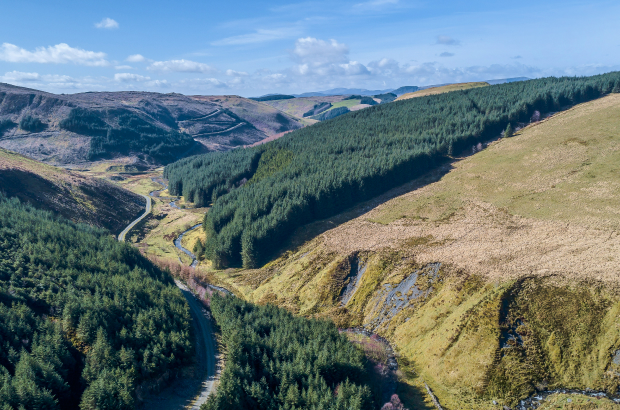Land Business Update | Week Commencing 30 September 2025
Farming & food
Agricultural land use in England (England)
Defra has published the latest data on land use, for the year ending on 1 June 2025. The main points are:
The proportion of England’s total area used for agriculture has barely changed in the past ten years, remaining at 68-69%.
The total croppable area has increased, by just under 2%, but what the area is used for has changed:
- The area growing crops has fallen by 12%, with particularly large falls in oilseeds and a 14% fall in the area used for horticultural crops, so economic responses from land managers to pest pressure and markets.
- These falls have been balanced by increases in the area fallowed, in temporary grass or in agri-environment schemes (which is now 5% of utilised agricultural area, so still low proportion compared with historical levels of set-aside).
The area of woodland on agricultural holdings has increased slightly to 4.4%.
The use of agricultural land for solar panels can be contentious, particularly for large solar farms. The data shows that 0.1% of agricultural area is used for them, or 0.07% of the total area of England, and that more than half of the area is also used for grazing or to produce other agricultural products.
Rollover of expiring CS agreements – over 4,500 farm businesses affected (England)
This analysis comes from The Land App, which says that these businesses with agreements due to expire on 31st December 2025 have no clear pathway into the reset Sustainable Farming Incentive (SFI). This has obvious financial and environmental implications and a range of organisations are calling for the government to allow a one-year rollover of expiring CS agreements until the reset SFI is available.
England’s first Commissioner for the Tenant Farming Sector is Alan Laidlaw (England)
Most recently the Chief Executive of the Royal Highland and Agricultural Society of Scotland, he has said that he wants to work directly with the sector to promote the Agricultural Landlord and Tenant Code of Practice, strengthen positive relationships and share what is learned through the Farm Tenancy Forum, which will monitor industry trends and share insights that help improve practice across the sector.
Natural capital & environment
Red Squirrel Awareness Week, 6th – 10th October (UK)
The week is about increasing awareness of and action for the UK’s endangered red squirrels and their conservation. This webpage has links to lots of online and in-person events being organised across the countries, including on ecology and habitats, and conservation solutions.
Wild bird populations in the UK and England (UK & England)
The combined bird species indices for the UK and England continue to show an overall decline. Since 1970, populations of wild birds have declined by almost one fifth in both the UK and England. Both indicators declined most between the late 1970s and the early 1990s, driven mostly by steep declines in woodland and farmland birds. Those two indicators then remained relatively stable or showed shallow declines until the mid 2010s, before in recent years showing a slightly accelerated downward trend. This decline is particularly associated with steep short-term declines observed in seabirds and farmland birds, although many of the bird groups show a decline in this period. For farmland birds, populations have declined at a fast rate, declining by 11% in the five years since 2019. S&P comment: the data shows that despite large numbers of farms in agri-environment schemes, populations continue to decline. This shows that it is vital to put the right options in the right places, in the right amounts and then managing them well for the schemes to reverse the declines.
More than 600 major organisations now committed to nature-related reporting
The Taskforce on Nature-related Financial Disclosure (TNFD) is an organisation that provides advice and recommendations on how organisations globally can report on nature. Its aim is to support a shift in investment toward nature-positive outcomes. Its first report on uptake shows that 620 organisations from over 50 countries, with $20 trillion of assets under their management, have publicly committed to getting started with nature-related reporting. Interestingly, over 60% of the firms and financial institutions surveyed for the report believe their nature-related issues are as significant, or more significant, than climate-related issues to the future prospects of their business. The TNFD guidance has now been downloaded almost 400,000 times – a massive show of interest.
CoastCraft game released to inspire learning about climate change and coastal flood resilience (UK)
The game has been developed following the success of the Rivercraft games, available on Minecraft Education, which cover flood risk management and nature-based solutions to flooding. In CoastCraft, players to respond to rising sea levels and the impacts of climate change such as flooding and balancing the needs of different communities while protecting the environment. It is based on the landscape of the town of Bude in Cornwall.
Rural economy & property
Housing (Scotland) Bill
The Bill has been passed by agreement between a number of political parties. Some of its main provisions are to cap rent increases at consumer price inflation plus 1%, subject to a ceiling of 6%. It also includes measures to ensure landlords deal quickly with health hazards such as damp. There are a number of exemptions, including that large, investor-funded rental developments will be exempt from rent cap provisions, which the government says is needed to encourage large scale investment.
Consultation on increasing water-saving features in new homes in changes to the Building Regulations (England)
The consultation proposes ‘small’ changes to the Regulations that would see new homes fitted with water-saving features such as aerated taps and showerheads, and dual flush toilets. The aim is to make new build housing more water efficient, saving @ 20 litres per person per day, which would save households around £100 a year on energy and water bills in new homes. It would also increase water availability for more new homes – an additional 1,000 new homes unlocked for every 5,250 homes built, according to the government. The national target is to reduce water usage in England to use 110 litres per head of the population by 2050.
Spruce Site Assessment grant – a proactive approach to tree health (England)
This new grant is available to woodland owners within the proactive spruce removal area to evaluate their spruce trees, estimate felling costs and plan for early removal of trees to reduce the risk of infestations of Ips typographus / the eight-toothed spruce bark beetle. Only 65 agreements are available and they are on a first-come-first-served basis. The grant is worth £2,000 per agreement. In addition, there will be improved funding for proactive tree removal, through an updated Tree Health Pilot programme, later this year. Equivalent support may be available in the other home nations.






